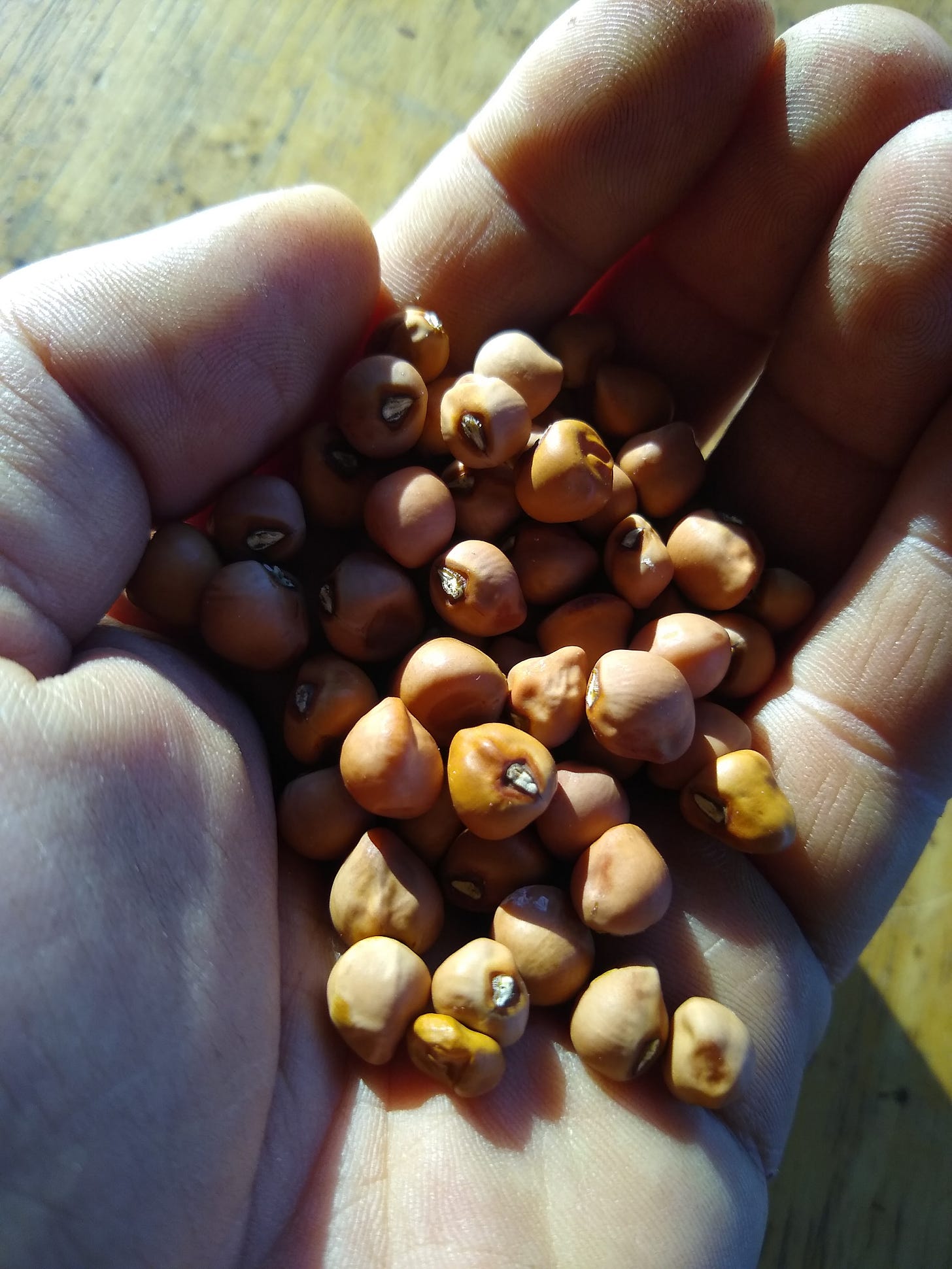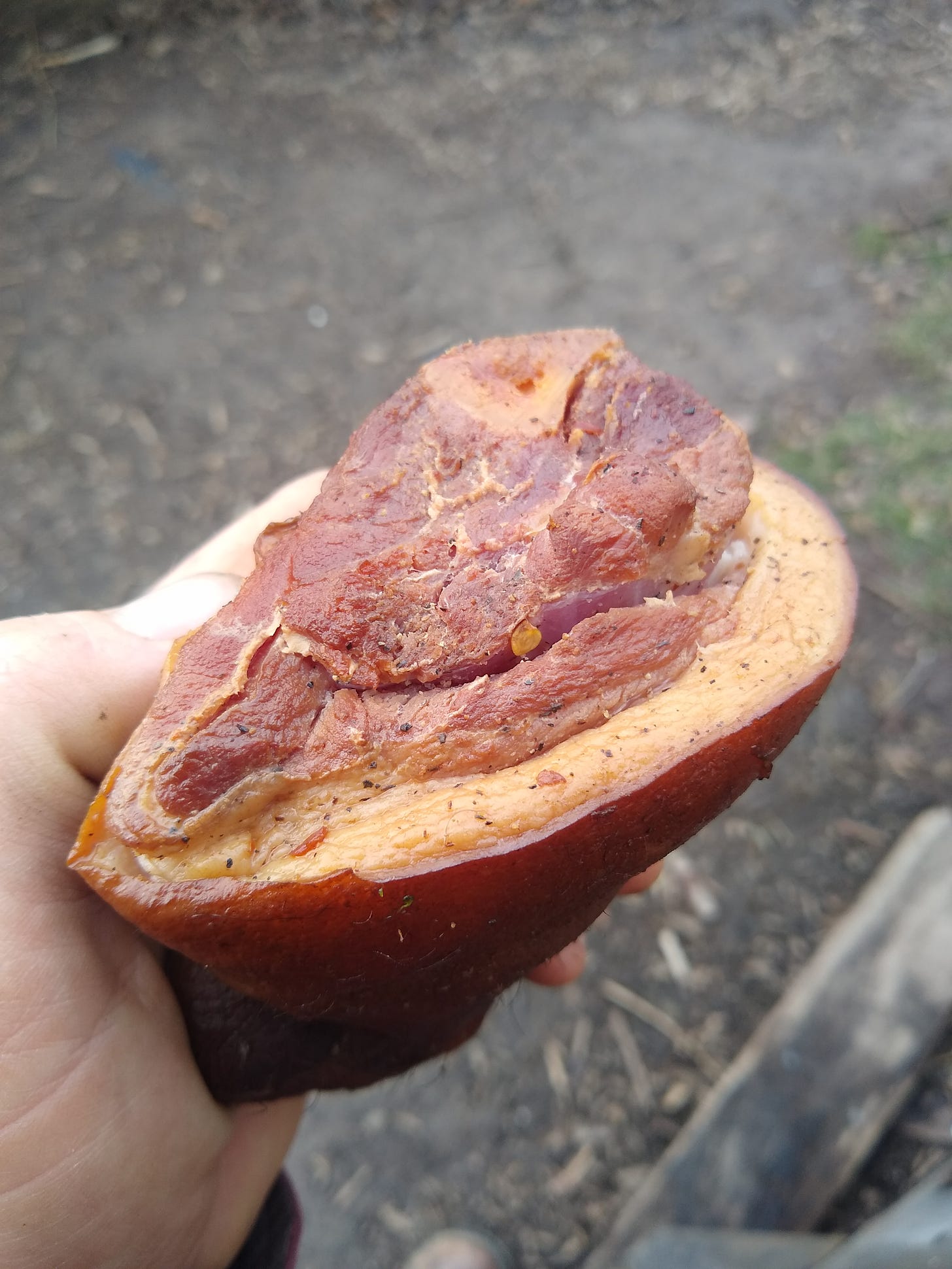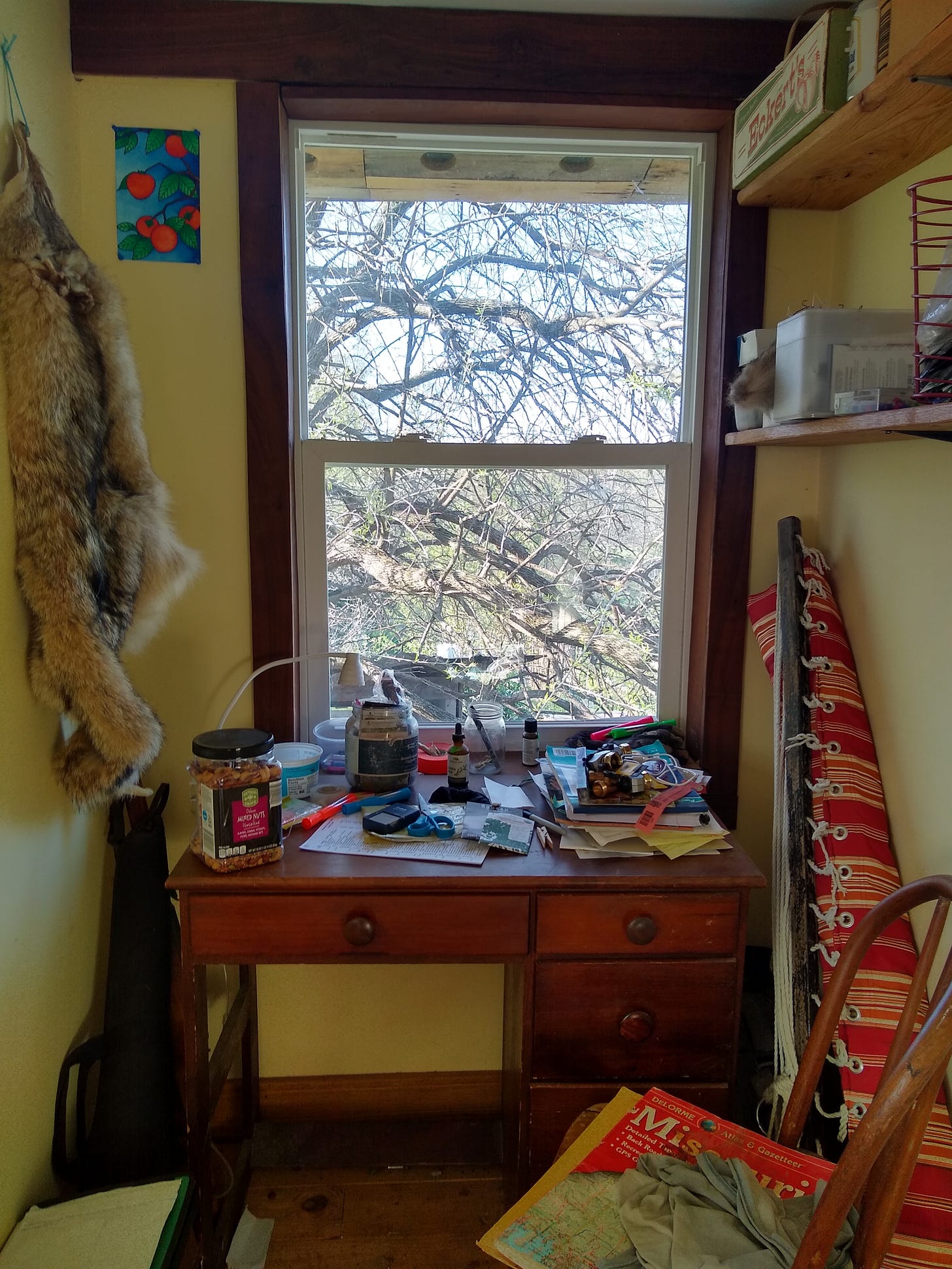Cowpeas, Survival and Liberation
The long roots of a New Year's tradition / Marking one year of this Almanac
The cowpea harvest was meager this year. By all accounts, they should have done fine: as a crop, cowpeas are hardly perturbed by heat and drought. We’ve been selecting ours for high production in adverse conditions for years, holding back seed from the longest pods (over 20 beans) which have suffered the most neglect. But cowpeas don’t begin to produce until fairly late in the growing season, and I was very much burnt out when the harvest window began. The fencing for our staple crops area, long needing repair, allowed a rabbit or two, and unlike myself, they seized the opportunity afforded them and filled themselves on the tender peas before they could dry down for picking. I shrugged it off at the time, but I regret it now.
I would contend that other than perhaps the pinto bean, cowpeas (Vigna unguiculata) are the finest annual legume I know of. It requires few inputs and is more easily digestible than other beans. Its rampant vines and fleshy leaves can provide fodder for livestock or roughage for humans in the wilting heat of summer. It is a plant that peasant people across the world have developed a deep relationship with, as is evidenced by the innumerable cultivars and distinct morphological types, from long-podded “yard-long” beans in Southeast Asia to plump crowder peas of the Southern US and the rough and durable staple varieties grown in the Sahel region of West Africa. In a world growing hotter and drier in many places, the lowly cowpea, which requires little in the way of inputs or even water is a legume to keep in our resilience toolkit.
Enzymatically speaking, the cowpea is a complete food. While it plays nice with others, a person could conceivably survive on them. The cowpea plant reproduces by means of a “perfect flower”, that is, it is difficult to hybridize, and usually produces “true seed”. An enterprising grower of cowpeas can grow multiple varieties side-by-side with little chance of producing a hybrid, though my sweetie has done this on one occasion, in which a Red Ripper bean crossed with Monkey Tail. So now, we are the only known purveyors of “Monkey Ripper” cowpeas. In a way, this perfect flower trait can relieve some of the complexities of plant breeding, allowing for little to no pollen isolation requirements. Beneficial mutations in the plant can thus more easily be selected for. For the record, we usually plant a couple new cultivars every year. We like Red Rippers for the flavor and preponderance of pods, Black Crowder for their aesthetic similarity to common black beans (though they have a much quicker cooking time), Iron and Clay for their preponderance of of lush vines as a cover crop and alternative fodder/hay crop, and Hercules because they got those big beans.
Like most beans, the cowpea, when combined with some marginal cut of pork, like a smoky hock, or fatback, or cartilaginous neckbone, undergoes a sort of alchemy. Low on the hog, the salted, fatty tidbits unfit for the plates of well-born, well-bred, genteel types are used in many traditions to lend depth and succulence to the homely bean. A loin, or chop of pork is a fine thing, but ultimately, it is not so nourishing as a pot of beans bearing that lip-smacking joint of skin and connective tissue, the hock. When the gentry have consumed their lean ration of fine-grained loin, the ham hock, in alliance with simple legumes, continues to give.
That neglected jewel of the pig: the ham hock, in all its salty, smokey glory.
Call it what you will, the cowpea, or southern pea, or black-eyed pea, is associated with future prosperity in Southern traditions of the US, particularly at New Year. Before crypto and multi-level marketing, it would seem that prosperity for common folks was promised most to those who demonstrated thrift. Those who might regularly fill up on a simple staple protein alongside the addition of one of the hog’s cheapest bits might well have been better able to stow away a few extra pennies here and there at the time this folk tradition came to be.
The cowpeas themselves have a coin-like appearance. How during the transatlantic slave trade cowpeas were brought to the Western hemisphere from Africa is unknown, though some folk traditions state that they were stashed in the hair of enslaved people. Cowpeas clearly had value: the resilient seed of a plant that kept people alive throughout West Africa (though some genetic evidence suggests it may have originated in East Africa) would again become a reliable staple in the strange and difficult world it would be deposited in. Naturally, as an African crop, white folks divorced themselves from the idea of consuming black eyed peas themselves, considering it food for livestock and the enslaved. Their own fortunes shifted during the scarcity of the Civil War. Robert E. Lee is quoted as saying that the black-eyed pea was “the only unfailing friend the Confederacy ever had”. If only he’d made it to present times to see all the support the Confederacy still has…
Why bring all this up? Because it is tradition among many in the South to eat Hoppin’ John for good luck and prosperity on New Year’s Day. The key components of Hoppin’ John are cowpeas, ham hock or some other smoked pork bit, and onion. Beyond that there are some variations, like pepper, vinegar and the like. A pot of Hoppin’ John is often made lucky with the addition of a coin (not so lucky if swallowed), though some traditions merely require a penny to be placed beneath the bowl of the eater. Fresh winter greens on the side, like turnip or mustard with their currency-like color, and cornbread the hue of gold all further enhance the potential prosperity of the new year. Hoppin’ John likely has its roots with the Gullah people of the South Carolina Lowcountry, and as such is served with rice like most everything else in the region.
The origins of the name Hoppin’ John are uncertain, though it has been suggested that it may be a corruption of the Haitian Creole name for cowpeas, pois pigeons, or pigeon peas.
Of course the world is a bit different now than when eating a frugal dish could so clearly be linked with future prosperity. Food is but one mere expense, and as many of you know, it is the costs associated with housing, healthcare and utilities which threaten to make present-day humans nothing more than debt modules to be traded and kept in perpetual servitude to the GDP. It is without land and land access that frugal eating becomes a symptom of poverty, and not some liberatory act. How might we write this story differently? Well you’ll have to stay tuned for the second year of the almanac.
We (that is, the Julian “we”, not the Lunar “we”) stand on the precipice of a new year, though the determination of when one year ends and another begins is completely arbitrary, the whim of some Roman king who did not account for either the lunar cycle nor the existence of leap days. But whatever. Concerning this almanac, I began writing, in earnest, on this day in 2022. I don’t know that all of y’all have had as much fun reading it as I’ve had writing it, and if I’ve learned anything in composing my thoughts in words, it’s that I cannot please everyone. I am largely unrepentant regarding anything I’ve said, but admit that given the privilege of time and space, I may have been better able to use my words.
My first post, written on the 28th of December, 2022, largely concerns dealing with iced up water troughs, and the physical properties of frozen manure. Today, it is balmy, muddy, and dreary. While it may not be evident in what I’ve published, I have grown as a writer in the intervening 365 days. There’s still plenty of manure-centric material, but the grammar has improved, and the process of sitting down to write is, in some ways, more natural to me.
Though I have omitted many unengaging details, I believe the first year of this almanac to have been an honest and true account of our life and this project, and as best as I can, I would like to express a deep gratitude to everyone who’s stuck with me. I am a talented complainer and not a person who naturally expresses gratitude. Y’all are not only keeping me centered on doing what I think is good and right, you have gifted me with the motivation to understand, document, and share. And of course, I need to acknowledge those who have been able to support this work financially. Believe it or not, I haven’t yet made my fortune writing, but I have been able to cover some various taxes and lease fees here, something that has long been a struggle. The support I’ve received, in the numerous forms I’ve received it in, has truly lifted me up. I hope this feeling continues.
My office. This is where the magic happens, folks.
I’ve struggled with creating a neat blurb to describe this project whenever I attempt to pitch it. Yes, it’s an almanac, in that it’s seasonal. But in a climate ever-careening into chaos, I am unwilling to make predictions. We have veered into food sovereignty politics, commons land models of the middle ages, agrarian labor struggles, and personal reflections on that unattainable sense of nativity and rootedness that plagues folks like myself who appear to be merely reenacting a settler model of land use. And if there’s been one consistent throughline, it probably involves poop. In the course of writing this first year I have begun several posts that haven’t yet made it into the almanac, posts that require more perspective, research or inspiration. I am excited for when I finally get to bring them to you.
Looking forward to 2024, I am holding the intention to begin a focus on the “solutions”, or at least the functional alternatives to a food system full of waste, inequity, and destruction. But I’m not going to promise any easy way out. I also intend to create a second handbook, similar to the scythe document, but on a different subject. Currently, I am compiling, editing, and formatting the complete first year of the almanac for printing, a little gift for my supporting subscribers. I have written over 85,000 words this year… enough for a nice-sized book. Within the world of writing, and outside of this almanac, I am also preparing to write another whole book entirely, should the time and focus continue to materialize. I’ll have more details to share on that project in due time.
Not counting the best seeds we’ve saved, there’s probably three cups of cowpeas available to me for New Year’s, but we have many forms of lowly, smoked hog bits and onion. And while between the deer, the rabbits and my own personal exhaustion our crop of cowpeas did not fair as well as some years, I still have placed next year’s seed in mouseproof containers atop the highest bookshelf on the homestead.
A flurry of seed catalogs has already arrived. I’m behind on a too much work to perouse them, or even plan much for next season. I will let these few jars of seed embody the hope and promise I cannot personally muster for now. This morning the sun has broken through the deep veil of cloud cover that has clung to these rolling hills and clay obscured river bottoms. It glints on a quarter-full jar of cowpeas, precious packets of genetic material, the resilient essence of subsistence and survival smuggled in the locks of the enslaved. And I wonder, how will we transmit our love, care, and support for future generations on uncertain territory in the form of seeds?
Seed saving, by definition, is a form of salvation. As the climate tips towards apocalypse and the inhumanity of genocide, apartheid, and colonialism is freely committed and unabated, seeds are both vulnerable to a world that appears to be entering a murder-suicide pact with itself, and a potential source for the continuation of human life.
And so yes, seeds obviously provide human survival, and some certain seeds might hold the key to a particular resilience that our continued existence requires. I think that’s a given. But seeds can also liberate us. Survival, or self-sufficiency for that matter, could be defined as the continued existence of a people, often allowed to persist on the grounds of the oppressor. Shelter, clean water, and requisite calories are the basis of humanitarian allowances, and are not even guaranteed under our current global economic socio-political regime. Just ask the people of Gaza, or Sudan, Myanmar, or the Central African Republic, or Iraq, Syria, Yemen, China or Bosnia or other places I do not know about. Perhaps, through humanitarian aid, basic life functions can be maintained. But specific seeds and their associated foodways must endure, if these people, just as deserving of existence as ourselves, are to continue to remain a people at all. Salvation is when people are allowed to live… liberation is when they are allowed to live as they always have. Ethnic cleansing, if it cannot erase a people entirely, seeks to erase their meaning. And meaning is found in the foods that cultures have developed relationships with.
In the case of the cowpea, enslaved Africans, taken away from their homelands, had their bond to place removed and eliminated. But by stowing away cowpeas, okra, and many other important crops, that bond, to admittedly different land, could be restored. In the Lowcountry of South Carolina and out among the Sea Islands, plantations were enormous, and the enslaved population massive. Unlike smaller plantations throughout the early US, these groups were quite isolated from ownership society, and despite the extreme abuse and hardship of captive life, a unique culture was borne out of old seeds planted in new soil.
Here in the western affluent world there are perhaps few similarities we could claim with the Gullah people of the Lowcountry. Or with innumerable refugees the world over who have been forced off their land by war, climate, and atrocity. But if the status quo continues as it has, I do suspect we may all be in need of seeds of our own, to press into soil to which we are not native.
This year, as evidenced by much of the almanac, I have pondered the question of rootedness, and specifically white rootedness on stolen land. And I haven’t quite come up with a satisfactory answer. In a world where the climate is rapidly changing and the borders of ecosystems shift and shrink, the concept of nativity is questionable. As ecosystems to our south die out or collapse, is it our job as stewards to bring them north? Like it or not, this is the Anthropocene, and our impact is undeniable. I suppose we have to choose, between liberation and mere survival, oppression or salvation. Regardless where we arrive, we will likely do as humans do, and bring our seeds with us.
Yours in dissemination and liberation,
BB
P.S. You can find seeds from threatened communities like Palestine, Iraq, Afghanistan and South Sudan through the Experimental Farm Network and Truelove Seeds. If you know of any food sovereignty centered seed businesses or projects out there, feel free to share in the comments.





